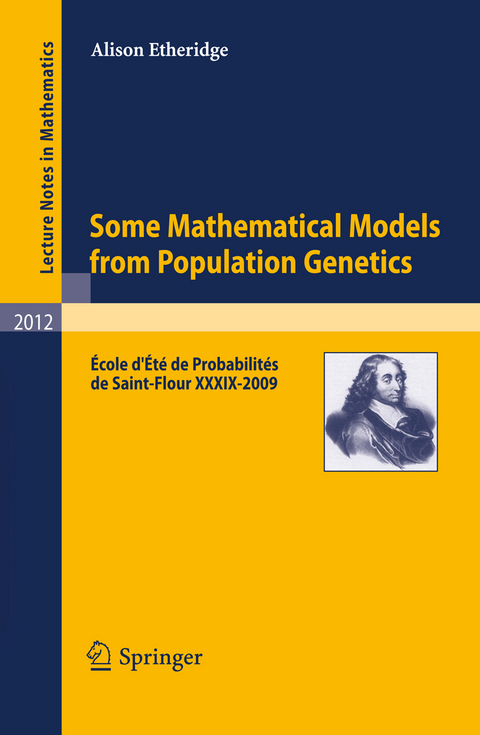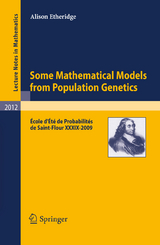Some Mathematical Models from Population Genetics
École d'Été de Probabilités de Saint-Flour XXXIX-2009
Seiten
2011
|
2011
Springer Berlin (Verlag)
978-3-642-16631-0 (ISBN)
Springer Berlin (Verlag)
978-3-642-16631-0 (ISBN)
Based on the author's lectures at the 2009 St Flour summer school in probability, this volume provides an introduction to a range of mathematical models that have their origins in theoretical population genetics.
This work reflects sixteen hours of lectures delivered by the author at the 2009 St Flour summer school in probability. It provides a rapid introduction to a range of mathematical models that have their origins in theoretical population genetics. The models fall into two classes: forwards in time models for the evolution of frequencies of different genetic types in a population; and backwards in time (coalescent) models that trace out the genealogical relationships between individuals in a sample from the population. Some, like the classical Wright-Fisher model, date right back to the origins of the subject. Others, like the multiple merger coalescents or the spatial Lambda-Fleming-Viot process are much more recent. All share a rich mathematical structure. Biological terms are explained, the models are carefully motivated and tools for their study are presented systematically.
This work reflects sixteen hours of lectures delivered by the author at the 2009 St Flour summer school in probability. It provides a rapid introduction to a range of mathematical models that have their origins in theoretical population genetics. The models fall into two classes: forwards in time models for the evolution of frequencies of different genetic types in a population; and backwards in time (coalescent) models that trace out the genealogical relationships between individuals in a sample from the population. Some, like the classical Wright-Fisher model, date right back to the origins of the subject. Others, like the multiple merger coalescents or the spatial Lambda-Fleming-Viot process are much more recent. All share a rich mathematical structure. Biological terms are explained, the models are carefully motivated and tools for their study are presented systematically.
| Erscheint lt. Verlag | 7.1.2011 |
|---|---|
| Reihe/Serie | École d'Été de Probabilités de Saint-Flour | Lecture Notes in Mathematics |
| Zusatzinfo | VIII, 119 p. 15 illus. |
| Verlagsort | Berlin |
| Sprache | englisch |
| Maße | 155 x 235 mm |
| Gewicht | 215 g |
| Themenwelt | Mathematik / Informatik ► Mathematik ► Angewandte Mathematik |
| Mathematik / Informatik ► Mathematik ► Wahrscheinlichkeit / Kombinatorik | |
| Naturwissenschaften ► Biologie ► Evolution | |
| Naturwissenschaften ► Biologie ► Genetik / Molekularbiologie | |
| Schlagworte | 60-02 • 60-02;92D10;92D15;60J70;60J75 • 60J70 • 60J75 • 92D10 • 92D15 • Coalescent models • Partial differential equations • Population Genetics • stochastic models |
| ISBN-10 | 3-642-16631-8 / 3642166318 |
| ISBN-13 | 978-3-642-16631-0 / 9783642166310 |
| Zustand | Neuware |
| Haben Sie eine Frage zum Produkt? |
Mehr entdecken
aus dem Bereich
aus dem Bereich
Buch | Softcover (2024)
Springer Vieweg (Verlag)
44,99 €
Anwendungen und Theorie von Funktionen, Distributionen und Tensoren
Buch | Softcover (2023)
De Gruyter Oldenbourg (Verlag)
69,95 €




